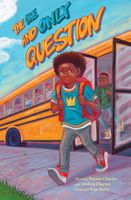- Welcome to FictionDB, Guest
- | My Account
- | Help

The One and Only Question — Norma Charles

It's Zeke's first day at his new school and his head is filled with one big question: what will he do when they call him the N—word like they did at his old school? Zeke is expecting the worst day ever, and that's what it's turning out to be. His favorite shirt has a mustard stain on it, the bus driver is unfriendly, and his teacher covers material Zeke has heard a million times. It’s not until another student performs a small act of kindness that Zeke realizes that no one has called him the N—word all day. Not once. And tomorrow could be even better … Ken Daley’s vibrant illustrations bring warmth and humor to the story, while showing hints of what makes this new school a safer space. The One and Only Question will prompt young readers to ask questions of their own about how to handle bullying — while also encouraging conversations about everyone’s right to a safe learning environment. Includes an author’s note explaining the authors’ personal connection to this story, as well as a list of suggestions about what to do about racism—based bullying to help educators, caregivers and victims.Key Text Features illustrations;dialogue;author's noteCorrelates to the Common Core State Standards in English Language Arts: CCSS.ELA—LITERACY.RL.2.3 Describe how characters in a story respond to major events and challenges. CCSS.ELA—LITERACY.RL.2.4 Describe how words and phrases (e.g., regular beats, alliteration, rhymes, repeated lines) supply rhythm and meaning in a story, poem, or song. CCSS.ELA—LITERACY.RL.2.7 Use information gained from the illustrations and words in a print or digital text to demonstrate understanding of its characters, setting, or plot. Describe how words and phrases (e.g., regular beats, alliteration, rhymes, repeated lines) supply rhythm and meaning in a story, poem, or song. CCSS.ELA—LITERACY.RL.3.6 Distinguish their own point of view from that of the narrator or those of the characters.
Click on any of the links above to see more books like this one.
